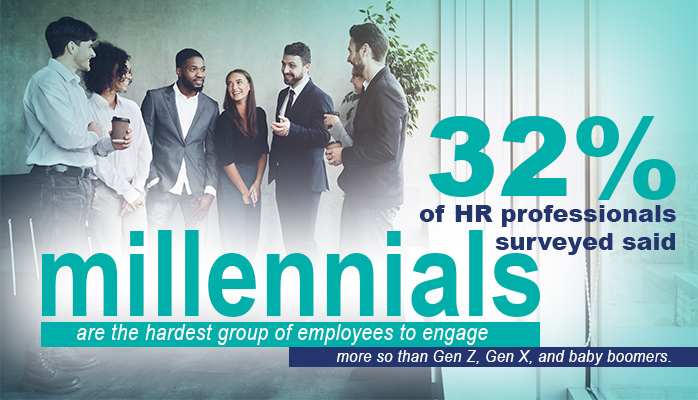
By Heather Nezich, courtesy SBAM Approved Partner ASE
It’s predicted that, by 2020, millennials will make up 35% of the global workforce. But according to the “Technology’s Role in Managing & Retaining Employees” research study released by Speakap, millennials are a double-edged sword for managers and HR professionals – while they are the most common generation in the workplace, they are also the hardest generation of employees to engage.
48% of the surveyed HR professionals in the US and UK reported that millennials make up the majority of their non-desk workforces. On top of that, 32% said millennials are the hardest group of employees to engage – more so than Gen Z, Gen X, and baby boomers.
As a generation, millennials value meaningful experiences over products, are more idealistic than pragmatic, are continuously in search of personal fulfillment (rather than ‘just another job’), and aren’t tolerant of subpar experiences—whether it’s the customer experience delivered by brands or the employee experience delivered by employers. They are really putting organizations to the test. Isn’t an employee not looking for ‘just another job’ what we all want? But that means we must offer this generation of employees an engaging and meaningful employee experience.
According to Erwin Van Der Vlist, Co-Founder & CEO of Speakap, there are specific ways companies can better communicate and engage with these younger generations of employees. “First and foremost, companies should tap into millennials’ intrinsic desire for personal fulfillment and a sense of purpose. A smart and secure way to do this is to take advantage of the socially intuitive experience (and user interface) provided by enterprise social networks and use these platforms to provide ongoing learning and development content. This will help your millennial workforce not only improve their job-related skills, productivity, and performance, but it will also make them feel personally fulfilled in their roles and more satisfied with the company.”
Key findings from the study include:
Technology-enabled HR is the rule, not the exception. Nearly three-fourths (69%) of the survey respondents said that their organizations currently implement technology-driven HR initiatives. 48% said that up to 45% of their total HR budget is allotted to technology designed for internal/employee communications.
High employee turnover is a problem that cannot be ignored. 75% of the surveyed HR professionals said they experience an average turnover rate of up to 30% each year. This is further supported by the fact that 15% of the respondents said their employees only stay for a duration of one to two years, while another 8% said the average duration of employment for their workers is less than one year.
Real-time feedback, socially engaging experiences, and mobile access influence engagement with millennial and Gen Z workers. 46% of the respondents said that their millennial and Gen Z workers want an employee communications platform with a similar functionality and experience to social media. 47% said their millennial and Gen Z workers prefer to have questions answered in real-time.
Improving employee-manager relationships and reducing turnover are bigger HR priorities with Gen Z workers than millennials and baby boomers. When asked to cite their top HR priority for managing Gen Z employees in 2019, 18% of the respondents cited ‘keeping employees engaged long-term’ and 13% cited ‘improving employee-manager relationships.’
When it comes to engaging baby boomers, mobile access and tech-enabled HR initiatives are less important. 45% of the surveyed HR professionals said their baby boomer workers rarely use social media/mobile apps, and 57% said this generation of employees are more likely to disconnect after working hours.
Inefficient, delayed feedback loop creates a black hole in employee communications. 39% of the surveyed respondents admitted to using paper surveys and 49% said they use the company intranet as a means of collecting employee feedback.
Erwin Van Der Vlist concluded, “A key takeaway from our research study is that HR departments should modify their employee communications based on the demographics of their employees. Given that millennials, Gen Z, and baby boomers all have different tech skills, mobile adoption rates, and expectations for the employee experience, this should be a no-brainer. I would recommend that organizations apply a buyer persona approach to their HR communications to better understand where their employees are searching for information online, what content employees are consuming most often, and what content has the greatest influence in persuading them to take an action. This will prove tremendously valuable if organizations – and their HR departments – want to make a meaningful connection with these workers and keep them engaged long-term.”